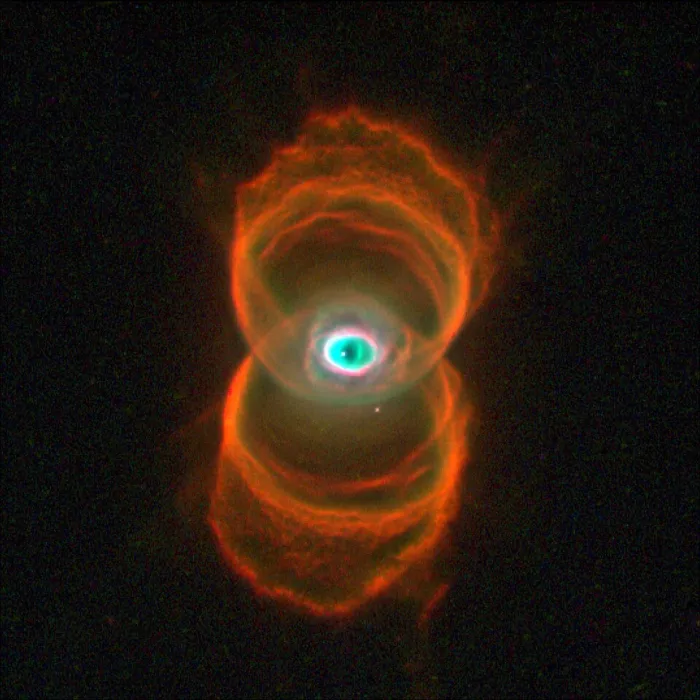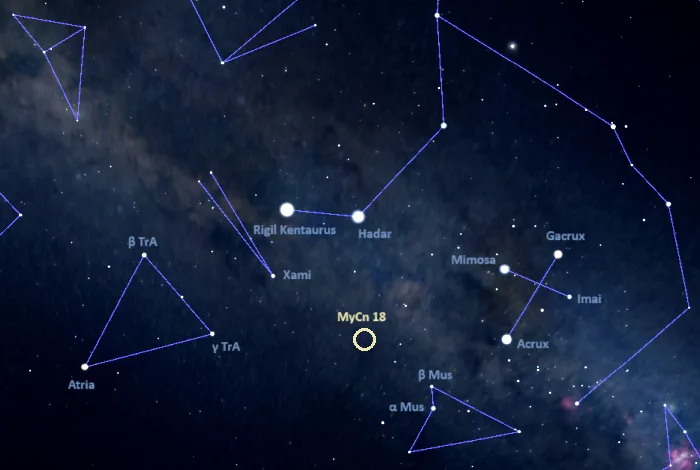The Hourglass Nebula (ESO 97-1, MyCn 18) is a planetary nebula located approximately 8,000 light-years away in the constellation Musca (the Fly). Also known as the Engraved Hourglass Nebula or Etched Hourglass Nebula, the young planetary nebula has an apparent magnitude of 13.0 and an apparent size of only 0.06 arcminutes. It cannot be observed in small and medium telescopes.
Like all planetary nebulae, the Hourglass Nebula formed when an aging red giant star reached the end of its life cycle and expelled its outer layers into space. As the gaseous envelope keeps expanding away from the stellar remnant, the intense ultraviolet light from the hot stellar core excites the gas, making it produce its own light.
Most Sun-like stars, including our own Sun, meet the same fate at the end of their evolutionary cycles. Like the central star of the Hourglass Nebula, the Sun will produce a planetary nebula in about 5 billion years.

The Hourglass Nebula (MyCn18) is a young planetary nebula located about 8,000 light years away. This artificially colorized image was taken with the Wide Field and Planetary Camera 2 aboard NASA’s Hubble Space Telescope. The image reveals the true shape of MyCn18 to be an hourglass with an intricate pattern of ‘etchings’ in its walls. This picture has been composed from three separate images taken in the light of ionized nitrogen (represented by red), hydrogen (green), and doubly-ionized oxygen (blue). The results are of great interest because they shed new light on the poorly understood ejection of stellar matter which accompanies the slow final stages of Sun-like stars. In previous ground-based images, MyCn18 appears to be a pair of large outer rings with a smaller central one, but the fine details cannot be seen. Image: NASA, ESA, Raghvendra Sahai and John Trauger (JPL), the WFPC2 science team, 16 January 1996. (PD)
The Hourglass Nebula will slowly disperse into space over the next few thousand years, and the progenitor star will gradually cool and fade as a dim white dwarf for billions of years.
The unusual appearance of the Hourglass Nebula, with two large outer rings and a small central one, has earned the nebula the nickname the Eye of God. The celestial Engraved Hourglass shares this nickname with the brighter and better-known Helix Nebula (NGC 7293) in the constellation Aquarius.
The Engraved Hourglass Nebula has a bipolar morphology with two circular bubbles. Its hourglass shape is thought to have been produced by a fast stellar wind expanding within a cloud that is denser at its equator than at its poles. The mechanism that produced the shape of the nebula’s inner “eye” is not fully understood.
The nebula extends 19 arcseconds along its long axis and is inclined 38 degrees to our line of sight. It has a physical radius of 0.29 light years. The outermost shells of material were expelled when the evolved central star was in an earlier stage of its evolutionary cycle.
The colourful appearance of the Hourglass Nebula in images taken by the Hubble Space Telescope (HST) is the result of different elements that were ejected in expanding shells around the central star. These elements are helium, nitrogen, oxygen, and carbon.
The central star of the Engraved Hourglass Nebula was discovered to be a binary system in 2018. Even though the planetary nebula nucleus (PNN) was long suspected to be a binary star because of the nebula’s hourglass shape, the binary nucleus was not successfully identified before 2018. A team of astronomers led by Brent Miszalski of the South African Astronomical Observatory used the Southern African Large Telescope (SALT) High Resolution Spectrograph (HRS) and found radial velocity variability with an orbital period of 18.15 ± 0.04 days in the nebula’s central region.
The team adopted a mass of 0.6 solar masses for the primary component and derived a mass of 0.19 solar masses for the companion, indicating a red dwarf of the spectral type M5V. The primary component has the spectrum of a Wolf-Rayet star.
The central dense stellar object has an exceptionally strong magnetic field that traps particles. The magnetic fields are thought to be responsible for the appearance of the nebula’s flattened rings.
The astronomers proposed proper motion as an explanation for the central star’s offset from the centre because the direction of the offset corresponds to the direction of the star’s proper motion. The team also suggested that the nebula’s jets and inner hourglass may have formed from some of the star system’s common envelope ejecta that stayed bound to the system in a circumbinary disk. The jets were likely ejected about 1,050 years after the main nebula. They are the fastest jets seen in a planetary nebula of 630 km s-1. The main hourglass is believed to have been expelled about 2,700 years ago, and the inner hourglass, about 950 years later.
The shape of the Hourglass Nebula has long been a mystery to astronomers. The nebula was once thought to consist of a pair of large outer rings and a smaller one in the nebula’s centre. However, advanced imaging has revealed that the bright inner elliptical ring is in fact a potato-shaped structure and that its symmetry axis is very different from that of the larger nebula.
The nebula’s distinctive hourglass shape was only discovered in the early 1990s, when Romano Corradi and Hugo Schwartz of the European Southern Observatory (ESO) in Santiago, Chile, captured CCD images and long slit spectra of three unusual southern nebulae. These were the Engraved Hourglass Nebula in Musca, the Southern Crab Nebula (Henize 2-104) in Centaurus and the symbiotic nebula around BI Crucis in Crux.
The astronomers noted that the Engraved Hourglass Nebula had a strikingly similar morphology to the Southern Crab Nebula, but they found no evidence that it was a symbiotic bipolar nebula like the Southern Crab and the nebula around BI Crucis. The Hourglass Nebula has much lower expansion velocities than the two symbiotic nebulae.
The ground-based images of MyCn 18 obtained by Corradi & Schwartz showed a striking resemblance to the triple-ring nebula seen around the supernova remnant SN 1987A in the Large Magellanic Cloud (LMC).
In 1999, a team of astronomers led by Raghvendra Sahai and John Trauger of the Jet Propulsion Laboratory at the California Institute of Technology (Caltech) in Pasadena, obtained images of the Hourglass Nebula taken with the Wide Field Planetary Camera 2 aboard the Hubble Space Telescope (HST). The Hubble images showed that the nebula has an overall hourglass shape, with a series of arcs that appear to be etched near the rims of the hourglass.
Imaging with Hubble also revealed a smaller hourglass and two rings in the nebula’s central region. The smaller hourglass structure is composed of the intersecting elliptical rings. The inner and outer hourglass, as well as the two central rings, all have different centres. None of these centres coincide with the central star. The reason why the central star is offset from the nebula’s centre remains unclear.

Engraved Hourglass Nebula, image credit: Judy Schmidt (CC BY 2.0)
Facts
The Hourglass Nebula was discovered by American astronomers Annie Jump Cannon and Margaret W. Mayall in the early 20th century. At the time, the astronomers were working on classifying stellar spectra for the extended Henry Draper Catalogue, which was published in nine volumes between 1918 and 1924. The object was simply described as a small, faint planetary nebula.
The Engraved Hourglass Nebula is catalogued as MyCn 18 in Margaret Walton Mayall and Annie Jump Cannon’s 1940 catalogue, ESO 97-1 in the European Southern Observatory Catalogue, Wray 16-132 in J. D. Wray’s A study of H-α emission objects in the Southern Milky Way, and Henize 2-95 in Karl Gordon Henize’s catalogue of nebulae.
The Hourglass Nebula has a namesake within the better-known Lagoon Nebula (Messier 8), a giant emission nebula in the constellation Sagittarius. Unlike the Engraved Hourglass Nebula, which is the final stage in the life of a Sun-like star, the Hourglass Nebula in M8 is a site of star formation. It lies at the centre of the larger Lagoon.
MyCn 18 was famously featured on the cover of the April 1997 issue of National Geographic. The editors noted, “Astronomers looked 8,000 light-years into the cosmos with the Hubble Space Telescope, and it seemed that the eye of God was staring back.”
Pop culture references to the Engraved Hourglass Nebula include the animated series Space Pirate Captain Herlock: The Endless Odyssey, the film Angels & Demons (2009), and the video games Final Doom, Mass Effect 2 and Mass Effect 3. The Hubble image of the nebula is featured on the cover of Pearl Jam’s album Binaural (2000).
Location
The Engraved Hourglass Nebula lies in the far southern sky, in the region between the Southern Cross and the Southern Triangle (Triangulum Australe). It can be found roughly halfway between Acrux (Alpha Crucis), the brightest and southernmost star in the constellation Crux, and Gamma Trianguli Australis, one of the three relatively bright stars that form the Southern Triangle. The nebula appears along the imaginary line connecting Beta Muscae in Musca and Xami (Alpha Circini) in Circinus.
The Hourglass Nebula appears only 1.5 degrees south-southeast of the Spiral Planetary Nebula (NGC 5189), another unusual planetary nebula with a binary star at the centre.
At declination -67° 22’, the nebula is best seen from the southern hemisphere. It never rises above the horizon for observers north of the latitude 22° N and stays very low in the sky when seen from the northern tropical latitudes.

Location of the Hourglass Nebula (MyCn 18), image: Stellarium
The best time of the year to observe the Hourglass Nebula and other deep sky objects in Musca is during the month of May, when the constellation appears higher in the sky in the early evening.
Engraved Hourglass Nebula – MyCn 18
| Constellation | Musca |
| Object type | Planetary nebula |
| Right ascension | 13h 39m 35.0596178496s |
| Declination | −67° 22′ 51.750497136″ |
| Apparent magnitude | 13.0 |
| Apparent size | 0.05905200’ x 0.05838017’ |
| Distance | 8,000 light-years (2,453 parsecs) |
| Radius | 0.29 light years |
| Names and designations | Hourglass Nebula, Engraved Hourglass Nebula, Etched Hourglass Nebula, Henize 2-95, Hen 2-95, MyCn 18, PN MyCn 18, ESO 97-1, WRAY 16-132, PN G307.5-04.9, ARO 530, VV 66, VV’ 115, PN Sa 2-96, PK 307-04 1, IRAS 13359-6707, 2MASS J13393507-6722518, AT20G J133934-672251, GALEX J133935.2-672251, DENIS J133935.0-672251, GSC 09003-00289, GSC2 S213122280, RCW 77, SCM 72, TIC 342722798, UCAC2 2440090, UCAC3 46-174497, UCAC4 114-076202, WISE J133935.08-672251.7, WISEA J133935.08-672251.7, Gaia DR2 5851342841411810304, Gaia DR3 5851342841411810304 |